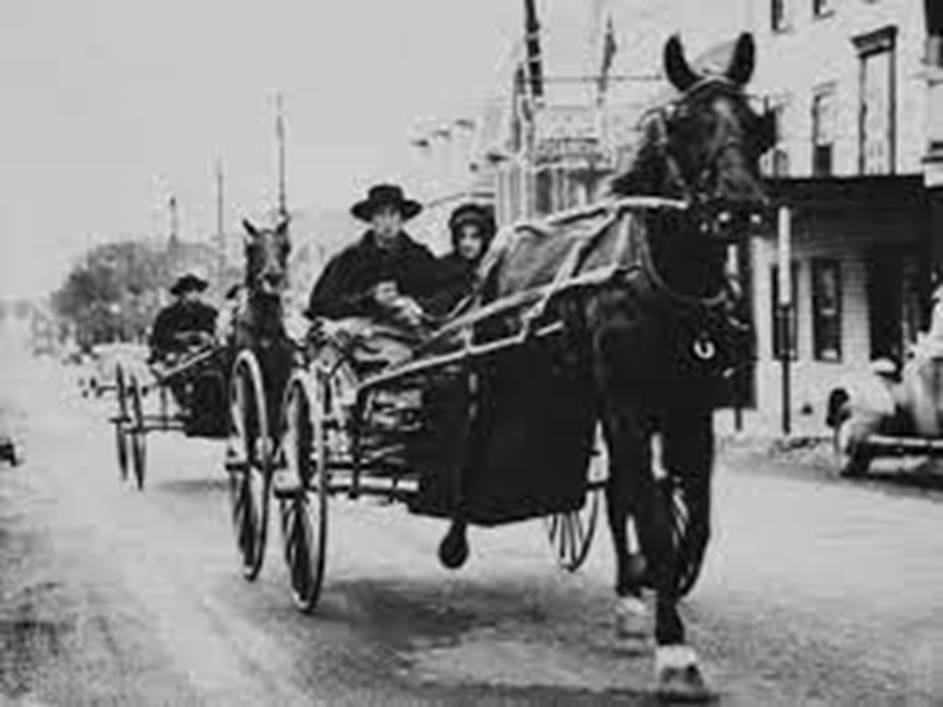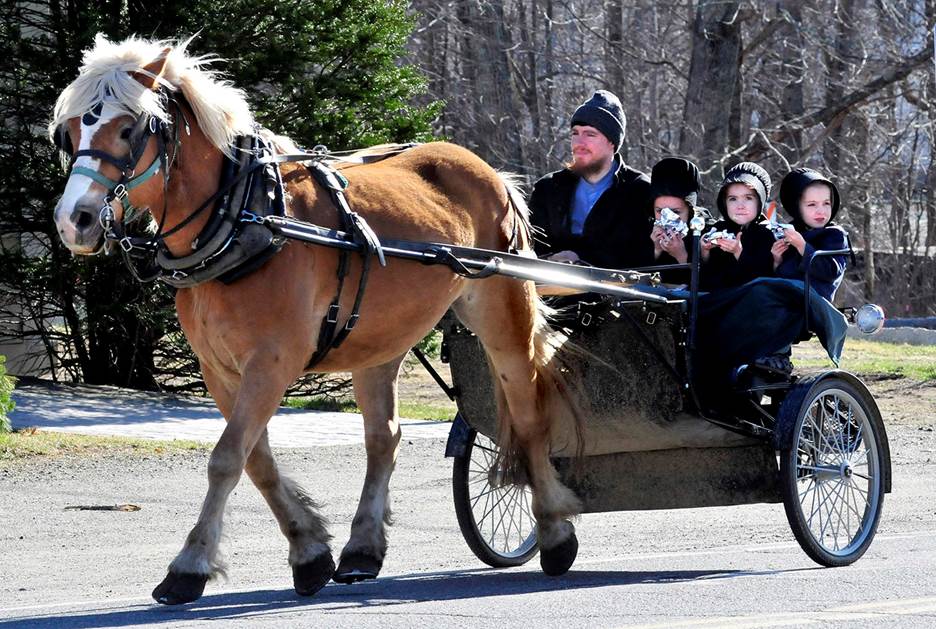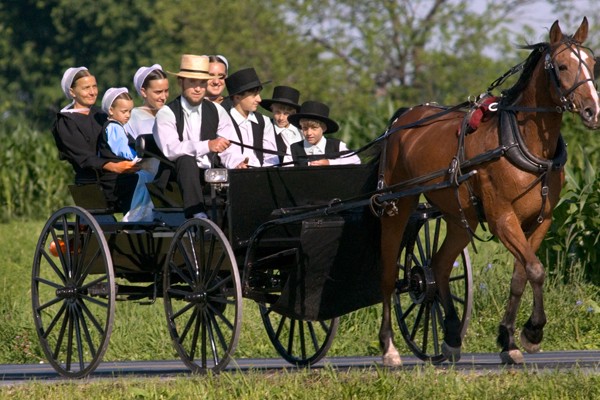
There are more than 370,000 Amish people in North America as of 2022, and about 62% of the population lives in Indiana, Ohio, and Pennsylvania - Yahoo News
How the Humble, Bucolic, and Self-Reliant Amish Way of Life Has Evolved over the Last 150 Years
By James Pasley & Taylor Ardrey
There's something about the Amish people that has captured America's imagination. With their plain clothes and horse-drawn carriages, they portray an idealized notion of living off the land.
In recent years, they've encountered controversy, including beard hate crimes. In 2011, five Amish men had their beards cut off with horse mane shears or clippers by a breakaway group of Amish late at night. Samuel Mullet, the man who organized the raid, along with seven of his followers, went to prison.
Recently, as #MeToo has swept through the West, the Amish have also had their own reckoning. Investigative journalist Sarah McClure discovered 52 prosecuted cases of sexual abuse in seven states over the last 20 years.
But many still see the Amish's bucolic lifestyle as idyllic. Instead of being judged on social media or competing in an urban rat race, their lives are devoted to community and to God. At one point, 90% of Amish people in America farmed their own land.
They dislike vanity and cannot pose for photos.
They work together. They don't deal in contemporary fashions. Beards are a key part of the Amish man's identity, symbolizing stability. Yet while beards are expected, mustaches are banned.
The Amish put the community first by avoiding individuality, which is clear from the plainclothes they wear. For males, it's black trousers, jackets, and hats.
For women, it's long dresses and bonnets.
The Amish believe through a simple, humble, somewhat-isolated lifestyle and, with hard work, that they can reach God.
Church is a massive part of their life. Inside, the mass is divided by men on one side, and women on the other.
They do not believe in war. They also can't hold public office or swear public oaths. Relatives still care for their elderly.
All of this has led to some people, who were fed up with the emptiness of modern life, to try to join the Amish. But it isn't easy, and according to a book called "The Amish," published in 2013, only 75 people joined and remained in an Amish church since 1950.

The Portland Press Herald
There are more than 370,000 Amish people in North America as of 2022, and about 62% of the population lives in Indiana, Ohio, and Pennsylvania.
Amish have large families. The average Amish family has seven children. For the rest of America, the average is less than two.
Along with a growing population, they also have less cancer, diabetes, and heart disease, compared to the rest of America.
One of the reasons for this is that desk jobs aren't the norm. In 2004, a study found an average Amish man walked 18,425 steps a day, and an average woman walked 14,196 steps.
Along with habits and exercise, the other main factor is their genes, according to Time. Since they don't typically marry outside of their community, the good genes have stayed with them.
Those genes came from Europe. Before coming to America, and before they were known as the Amish, they were a faction of the Anabaptists and had already proven their farming skills. They rotated crops to get the most out of their soil.
They planted clover in fields and sweetened the earth with lime and gypsum. This meant their yields were large, and they thrived.
According to Wired, "they started out as radical religious libertarians — at a time when the price of religious radicalism was martyrdom."
In the 1730s, they left their fields. About 21 families fled Europe to escape religious persecution aboard a ship called "Charming Nancy." They settled first in Pennsylvania.
Over the next 100 years, more Amish migrated to America. In total, 200 Amish families arrived in the US. They've since spread out across much of America, and in particular in Indiana, Kentucky, Michigan, New York, Ohio, and Wisconsin.

Youair Blog
They live in small communities, or "church districts," of about 20 to 40 families, according to Cosmopolitan. Each community has its own set of rules called the "Ordnung."
They even distribute their own publication called "The Budget," a weekly issue including newsletters and reports which has been published since 1890. It focuses on local matters like marriages, church attendance, and missing farm stock.
Developing technology has long been a concern for the Amish. In the 1910s, as phones became common, "the Old Order Amish recognized that the caller at the other end of the line was an interloper, someone who presumed to take precedence over the family's normal, sacred, communications," according to Wired.
The Amish decided the rightful place for a telephone was outside of the house in a shack or outhouse.
The Amish also banned cars. They thought driving would cause their communities to drift apart, since cars can travel much further and faster than horse-pulled carts.
They want to keep their communities close.
For the same reason, they aren't connected to electricity grids. For years, they tried to avoid using electricity completely. One Amish man told Wired: "The Bible teaches us not to conform to the world, to keep a separation."
"Connecting to the electric lines would make too many things too easy," he said. "Pretty soon, people would start plugging in radios and televisions, and that's like a hotline to the modern world."
He added: "We try to restrict things that would lead to us losing that sense of being separate, to put the brakes on how fast we change."
But over the years the Amish's position softened, and now many use electricity — as long as it's connected to generators, and not to the main grid.
Another way the Amish differ from the rest of America is their education. Amish children stop going to school after eighth grade. They then learn trades or how to care for families. For a long time, children were also chastised for raising their hand in class because that was too individualistic.
But the Amish's schooling decision was controversial legally. In 1962, at least 10 Amish men in Iowa were found guilty on charges relating to their refusal to force their children to remain in schools — eight of whom were jailed for three days for failing to pay fines.
The Supreme Court later unanimously held in 1972 that the Amish were exempt from compulsory schooling past the eighth grade.
After schooling at 16 years old, teenage Amish get to choose whether they'll remain Amish. They enter a period called the "rumspringa," which roughly translates to "running around." After this period of freedom, they have to choose whether or not to return and follow the Ordnung.
Studies have found at least 80% end up joining the Amish church, despite all of the temptations of modern society like music, electricity, cars, and alcohol. Something pulls the majority back.
And that something also led to the Amish's rural lifestyle morphing into a tourist attraction. Although hesitant at first, many began to see it as a way to earn money.
Amish bakeries and bed and breakfasts opened, and shops started selling furniture and quilts. One Amish woman compared tourism to the ticking of a clock. "You don't even hear it after a while," she told The New York Times.
In 1985, Hollywood portrayed the Amish in the film "Witness," starring Harrison Ford. According to The New York Times, the Amish, who couldn't see the film, had mixed feelings about it and didn't care that Ford had been in Star Wars. But unlike tourism being like the sound of a ticking clock, movies were "like chimes" and could not be ignored.
In the 1990s, according to the Los Angeles Times, rising land prices put pressure on the Amish, who are expected to provide land for their children. By 1993, land prices had doubled from eight years earlier.
From about 1970 to 1990, about 2,500 acres of farmland in Lancaster County, which houses the most well-known Amish settlement in America, was being developed annually, even as the Amish population continued to grow.
A few years after that, in 1993, there were about 130,000 Amish in the US.
In 1997, an Amish man named Moses Smucker told The New York Times: "It's pretty simple. There is not enough land needed to farm. People are making other choices." And they did. The Amish moved from exclusively working the land to technical work like carpentry, factory work, and construction.
By 1997, people were so drawn to the Amish way of life that Amish communities were attracting up to five million tourists each year.
Along with tourism, they moved from trade to trade, including dairy farming, barn building, goat rearing, and selling vegetables. They were adaptable and did whatever was necessary to survive.
"More and more, we're becoming business people. And I'm not so sure our leaders, the ministers, and bishops, know how to deal with it," Smucker told The New York Times. "They're getting the hang of it. But they're still uncomfortable with it.''
But the seemingly peaceful way of life of Amish communities came to a screeching halt in 2006, when a local milkman entered an Amish school and shot 10 girls, killing five of them. But within hours, the Amish announced they forgave the killer.
In 2006, the Amish way of life clashed with modern society over milk. An Amish man named Arlie Stutzman was caught selling unpasteurized milk by an undercover agent from Ohio's agriculture department. The department argued that it was illegal to give milk away.
But Stutzman said: "While I can and I have food, I'll share it. Do unto others what you would have others do unto you."
By 2012, Amish settlements had spread out into 30 states, particularly along the east coast in Maine and New York. They were looking for less populated rural areas to live on.
At the same time, they were dealing with even more technology. Throughout the 2010s, Amish began to use computers and mobile phones. The internet, which is hard to ignore, once again raised concerns about the changing way of life for the Amish.
It took away the need for independent thinking, one Amish man told The New York Times.
As the years go on, the Amish continue to grow. "We can't live like we did 50 years ago because so much has changed," one Amish woman told The New York Times. "You can't expect us to stay the same way."
"We love our way of life, but a bit of change is good," she said.
Despite not usually participating in politics, the Amish had a high voting turnout in the 2020 presidential election supporting Donald Trump, according to Lancaster Online.
"It was hard to decide whether to vote, and we decided to continue doing what we've always been doing. I didn't know who to vote for," one Amish man, who said his family didn't vote, told Lancaster Online in 2020. "The other thing is we hope that God will take control and He brings in the right person," he added. - Insider

